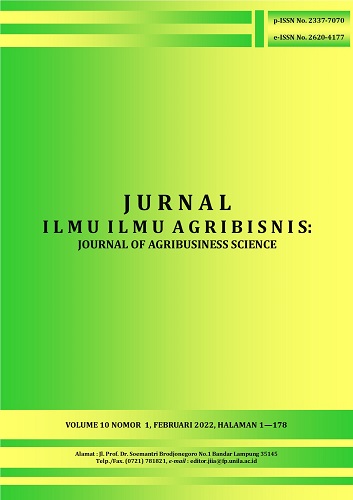ANALISIS KELAYAKAN FINANSIAL USAHA TERNAK AYAM RAS PETELUR (STUDI KASUS TAKIHARA FARM) DI KECAMATAN NATAR KABUPATEN LAMPUNG SELATAN
DOI:
https://doi.org/10.23960/jiia.v10i1.5644 Abstract View: 908
Abstract View: 908
Abstract
The aims of this research are to analyze the financial feasibility and the sensitivity of laying hens farming. The research was a case study at Takihara Farm in Natar Subdistrict of South Lampung Regency. Data were collected in August 2020 and analyzed by using financial feasibility and sensitivity analysis methods. The results showed that laying hens farming was financially profitable and feasible to be developed. The NPV of laying hens farming was IDR10,131,628,683.22. The Gross B/C value of laying hens farming was 1.15. The Net B/C value of laying hens farming was 2.17. The Payback Period value of laying hens farming was 13.81 years, showing that the initial cash outflow of investment could be recovered less than 30 years. The IRR value of laying hens farming was 13.84 percent, which was greater than interest rate 6 percent. Based on the results of the sensitivity analysis, with an assumption of an increase in the production costs of corn as a feed ingredient for laying hens by 10.73 percent and a decrease in the selling price of chicken eggs by 12.44 percent, the business of laying hens farming is still worth cultivated and developed.
Key words : financial, laying hens, sensitivity
Downloads
Downloads
Published
How to Cite
Issue
Section
License
Authors who publish with this journal agree to the following terms:
Authors retain copyright and grant the journal right of first publication with the work simultaneously licensed under a Creative Commons Attribution License that allows others to share the work with an acknowledgement of the work's authorship and initial publication in this journal.
Authors are able to enter into separate, additional contractual arrangements for the non-exclusive distribution of the journal's published version of the work (e.g., post it to an institutional repository or publish it in a book), with an acknowledgement of its initial publication in this journal.
Authors are permitted and encouraged to post their work online (e.g., in institutional repositories or on their website) prior to and during the submission process, as it can lead to productive exchanges, as well as earlier and greater citation of published work (See The Effect of Open Access).














